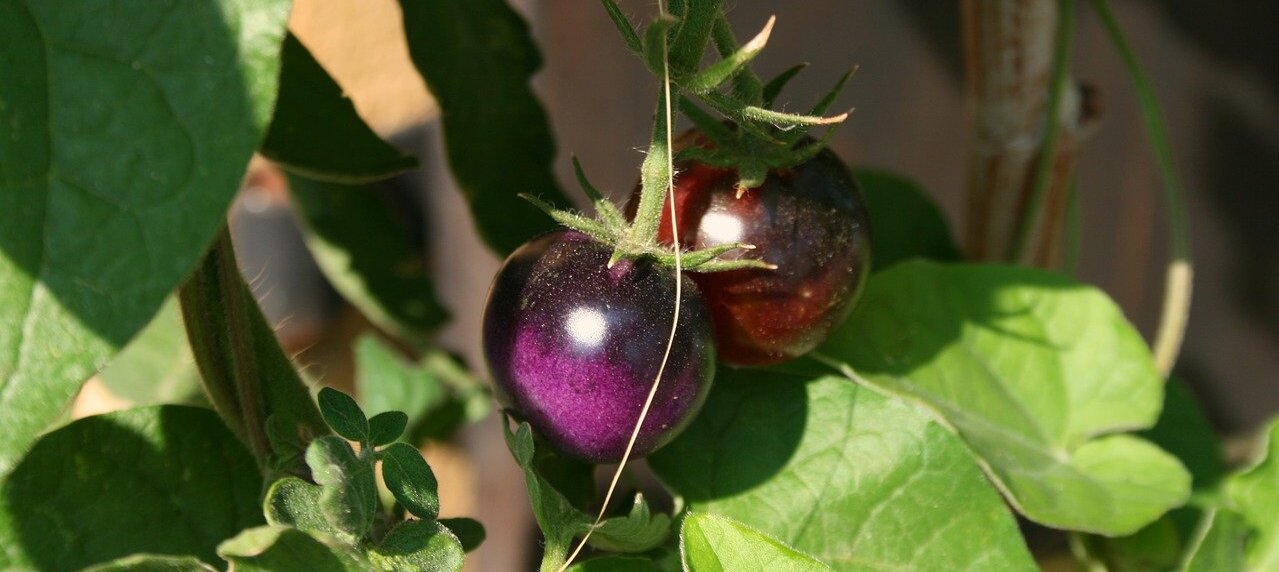Purple tomatoes are purple pigmented specialty tomato types. The tomatoes are available in many varieties and can be heirlooms, open-pollinated hybrids, or genetically engineered cultivars. Although purple in color, purple tomatoes are generally raised following the same methods as those applied to growing regular tomatoes. In addition, they have a variety of culinary applications and may have a slightly different flavor from regular red tomatoes, for example.
Table of Contents
What are Purple Tomatoes?
Purple-colored tomatoes, which are sometimes referred to as blue or black tomatoes, are a bonafide member of the species Solanum Lycopersicum. This is to say they are fully edible tomato fruits in their own right, a source of umami flavor, and also belonging to the Solanaceae or Nightshade family. Other family members include potatoes, eggplant, and peppers.
Although they may start off as green as their red tomato cousins, purple tomatoes typically ripen with a deep purple pigmentation which can also resemble blue or black color depending on growing conditions.
According to a study published in the journal, Food and Nutrition Research the depth of the purple color of the tomato is influenced by pH, temperature as well as genetics. Higher pH turns the color to look blueish, for example.
Nonetheless, there are many purple tomato cultivars available today. These tomato types are split among heirlooms, open-pollinated hybrids, and genetically engineered cultivars. They differ in size, shape, texture, and even days to maturity.
Heirloom-type purple tomatoes tend to be very fleshy. They are also prone to disease compared to hybrid types. Furthermore, some heirloom types such as Black Prince and the Cherokee purple tomato may have purple skin and a reddish interior.
By far, the majority of purple-colored tomatoes available on the market and to grow are hybrid varieties intentionally bred for their health benefits which we shall later discuss in detail.
All in all, purple tomatoes have a wide range of applications which in many cases mimic those of regular red tomatoes. They are used in sandwiches, salads, canning, and in making pizza and pasta sauces.
Useful Tomato Kitchen Utensils
There is much more to be done with tomatoes that many people actually get to do. Much of what can be done with tomatoes calls for certain simple but handy kitchen utensils and equipment. The following is our list of useful items to consider when working, not only with purple tomatoes, but all kinds of tomatoes in general.
- Tomato strainer
- Tomato/Salsa Blender
- Food Processor for Tomatoes
- Tomato press
- Tomato mandoline for slicing
- Tomato slicer holder
- Heavy duty tomato slicer
- Tomato dicer
- Tomato corer
- Tomato jars for canning
- Tomato knife
- Tomato saver
- Countertop storage basket
- Tomato growing pots
Why are Purple Tomatoes Purple?
Depending on the cultivar, purple-colored tomatoes are purple in color as a result of anthocyanins, a water-soluble biochemical compound that gives the tomato its color.
Anthocyanins are not only found in tomatoes but also in blueberries, purple cabbage, purple broccoli, purple lettuce, eggplants, basil, and certain grapes among a range of fruit and vegetables.
Furthermore, berries have the most amount of anthocyanins per serving compared to a wide range of other black or purple-colored fruits and vegetables. For example, in total, a fresh purple tomato has only 5 to 10% in anthocyanins of that found in blueberries.
Nonetheless, although they may look purplish in color, certain purple heirloom tomatoes such as Black Prince and Cherokee, do not derive their color from anthocyanins.
Apparently, these purple tomatoes get their color from a different source altogether. This has implications on their functional health benefits compared to other purple tomatoes.
Behind the scenes, these heirloom tomatoes have what is referred to as the green flesh gene. This gene prevents chlorophyll from breaking down to pave the way for the carotenoids which normally lead to a ripe red tomato. The gene, instead, produces pheophytin, a brown chemical compound.
As a result, what you get is a muddy brownish-purple color which is essentially a mixture of pheophytin and carotenoids. The pheophytin fails to clear to give way for the carotenoids to present a fully red ripe tomato.
An exception to this albeit with its own limitations would be the Purple Smudge tomato, which is an heirloom variety. Purple Smudge ripens with purple spots on the upper half of the tomato whilst the rest of the tomato remains orange in color.
The limited purple color on the tomato is derived from anthocyanins existing in the colored spots. This tomato never gets to extensively put on purple as one generally gets with the modern hybrid purple varieties.
Thus the point we make is that the purple color in purple tomatoes is from different sources as much as non-heirloom purple tomatoes primarily derive their purple color from anthocyanins.
Purple Tomato Origins
The origins of purple tomatoes are a mixture of old history and recent history. The heirloom type of purple tomatoes, for example, can be traced back to the 1800s. This is in reference to Cherokee purple tomato, in particular, which may have links to Cherokee Indians by some accounts.
This particular tomato was rediscovered by Craig LeHoullier in 1990 through a pass down that followed many generations. Craig LeHoullier received the seeds of the tomato in an unmarked packet from J. D. Green of Tennessee in the United States. He is credited for giving the tomato cultivar its current name – the Cherokee purple. The 90s rediscovery apparently resurfaced the tomato variety, as it were.
However, purple tomatoes specifically bred in pursuit of anthocyanins for health benefits, have a more recent history. For example, the Indigo Rose originated in 2006. It is a popular purple tomato developed by Kim Myers of the Oregon State University (OSU).
Another example is the Black Beauty purple tomato which was developed in 2012 as a cross between Pink Berkeley Tie-Dye and Indigo Apple tomatoes. Indigo Apple itself, is another purple tomato creation of OSU.
In 2021, OSU further released yet another purple tomato by the name Midnight Roma. This is a purple-colored Roma tomato that mimics its red cousin.
As earlier mentioned, the origin of purple tomatoes is split between heirloom varieties which have a much longer history, and hybrid varieties purposefully developed in recent years at universities and other research institutions.
While it is much easier to trace the origins of modern purple tomatoes, as already demonstrated, the same cannot be said about heirloom types that seem to have traveled through time following a now hazy generational pass down.
Purple Tomatoes vs Red Tomatoes
The first and foremost and certainly obvious distinction between purple and red tomatoes in the ripening color. Purple tomatoes ripen with blue or purple color while red tomatoes ripen with the traditional intense red color many are accustomed to.
The second important but yet not as apparent difference is that purple tomatoes offer superior health benefits compared to red tomatoes. Whereas red tomatoes are as nutritious as purple tomatoes, the latter goes a step further, on account of anthocyanins, and offers functional health benefits such as anti-cancer, anti-diabetic, anti-inflammatory, and blood-pressure-lowering effects.
This article, Anthocyanins—More Than Nature’s Colours, by the Journal of Biomedicine and Biotechnology sheds more light on the health benefits of anthocyanins as found in purple tomatoes. For this reason, if one was to pick between purple and red tomatoes on the basis of health benefits, the obvious choice would be the purple varieties.
Concerning flavor, shape, size, and texture, these are all dependent on the type of purple tomato under consideration. Juxtaposed, many heirloom purple-colored tomatoes have a similar resemblance to many heirloom red tomatoes. They are fleshy and juicy much in the same way as their cousins. Furthermore, they also share similar culinary applications as their red counterparts.
Compared to red tomatoes, purple-colored tomatoes have a longer shelf life according to the journal Current Biology. According to some reports around purple tomatoes such as the Big Purple Tomato, purple-colored tomatoes can have as much as double the shelf life of the regular red tomato.
Assuming the tomatoes become mainstream and accepted, this is a game-changer considering the amount of waste associated with red tomatoes going bad.
Yet another difference between purple and red tomatoes is that purple tomatoes are resistant to some known tomato diseases and bugs that would ordinarily affect red tomatoes. Speaking of pests, certain pests that are attracted to ripe red tomatoes on the vine do not find purple tomatoes as attractive, which reduces fruit loss.
Finally, side-by-side, many consumers still find red tomatoes more aesthetically pleasing and attractive compared to purple-colored tomatoes. At the current stage, purple tomatoes may seem to be suffering the same fate as some purple sweet potatoes or purple potatoes.
However, consumers may begin to embrace this type of tomato as its health benefits are widely understood and appreciated. In the meantime, purple tomatoes are still considered specialty tomatoes of much less popularity compared to red tomatoes.
Purple Tomato Varieties
As earlier stated, there are many purple-colored tomato varieties. The following is our compilation of some of the currently available and upcoming purple tomato varieties. All in all, there are over two dozen purple tomato varieties.
- Big Purple Tomato – is a UK-developed purple-colored tomato variety that is currently (Feb 2022) seeking regulatory approval for the U.S. market. The tomato is a GMO variety that was purposefully developed to be laden with health-beneficial anthocyanins. The developers have suggested that the tomato is the ultimate anthocyanin-rich vegetable with twice the level of anthocyanins in blueberries.
- Midnight Roma Tomato – this is a Roma tomato variety that is however purple-colored. Midnight Roma was developed by Jim Myers at Oregon State University College of Agricultural Sciences. The tomato is an anthocyanin-rich cross between Oregon Star and Indigo Rose, another purple tomato variety. The tomato is good for home canning and for making soups. It is considered a processing tomato.
- Indigo Rose – this is yet another purple-colored fruit from whence Midnight Roma, discussed earlier above, is bred. This is an indeterminate tomato also developed at OSU. It is a high-yielding tomato plant that produces fruit that darkens to purple on the parts of the tomato exposed to light, usually the upper end. The fruit typically has some parts red while those fully exposed to light turn purple. The tomato ripens in 75 to 80 days.
- Dwarf Purple Heart – This is a 2010 purple tomato variety that, in keeping with its name, is dwarf tomato shaped like a heart. The fruit of this variety grows to become medium to medium-large in size. It was developed by the Dwarf Project as the cross between Dwarf Wild Fred and Porky. The tomato ripens with a dusky rose-purple hue.
- Cherokee Purple Tomato – no heirloom purple tomato discussion is quite complete without mentioning the legendary Cherokee purple. This tomato, as earlier considered, is not purple-looking due to any anthocyanins. The tomato variety is purple due to a different process revolving around the green gene that fails to give way to the red pigmentation. Cherokee Purple has a beefsteak shape and can be sliced for BLT sandwiches and salads. When planted, expect a ripe harvest in 80 to 90 days.
- Owen’s Purple – this is one of the many purple-colored tomatoes which falls on the lighter end of the purple spectrum. This purple tomato variety is not as deep purple or even as black as Midnight Roma or Indigo Rose, for example. It is nonetheless a sweet flavored tomato developed by Jinnie Farrell as a cross between Paul Robeson and Mortgage Lifter tomatoes. It has a perfect and uniform look with one of its signature characteristics being a crack-free tomato.
- Helsing Junction Blues – this is a 2012 purple tomato variety that was developed by Tom Wagner. The variety is named after Helsing Junction Farm in Washington. Helsing Junction Blues is a purple-black-looking round-shaped cherry tomato fruit. You did apply this tomato in a variety of dishes as you would do other black cherry tomatoes.
Growing Purple Tomatoes
Growing purple tomatoes follows the same cultural practices as growing red tomatoes. As earlier stated, purple-colored tomatoes are of similar species as regular red tomatoes. For this reason, almost the exact same methods are used when growing purple tomatoes.
Similar to regular tomatoes, purple-colored tomatoes can be raised on the ground or in containers. Certain varieties such as dwarf purple tomatoes are best suited for containers and can also be grown as patio tomatoes.
What is to remember is that purple-colored tomatoes will require warm weather to thrive. They are sun-lovers that will also require full sun preferably of no less than 6 hours per day.
The soil used to grow tomatoes is best mixed with compost and peat moss, especially when raising the tomatoes in containers. To prevent blossom end rot which is associated with calcium deficiency, bone meal is added to the soil at the planting stage.
The soil in which the tomato plants are grown must be kept moist and regularly watered. Even purple tomatoes are prone to cracking. One of the main causes of cracking in tomatoes is allowing the tomato plants with fruit to suffer moisture stress and then watering them. Tomato cracking can also happen if it rains following a period of drought.
When to harvest purple tomatoes will be guided by the date to maturity as indicated on the seed packet. However, it is not always straightforward to tell when to pick the tomatoes since they do not turn the obvious red that many growers are used to. For this, we prepared a detailed guide on When to Pick Tomatoes which discusses many tomato types including green tomatoes and purple-colored ones.
There is certainly more to appreciate about raising tomatoes. This resource, Growing tomatoes in home gardens, by the University of Minnesota Extension offers a detailed guide which is very useful when not only growing purple tomatoes but any tomato type in general.
Conclusion
There are a wide variety of purple tomatoes available to grow as well as to consume. These tomatoes include age-old heirloom varieties and modern types developed specifically for their health benefits. As much as modern purple-colored tomatoes get their color from anthocyanins, this is not the case for some heirloom varieties. Although they remain specialty tomatoes, purple tomatoes have just about the same culinary applications as their regular red tomato counterparts.
Random But Good Reads:
- Purple Lettuce Information
- Frisée Lettuce Information
- Cinnamon Basil Information
- Purple Broccoli Information
- Pimento Peppers Information
- Buttercrunch Lettuce Information
- Boston Lettuce Information
- Yellow Pear Tomato Information
- Patio Tomato Information
- Recipes with Pork Chops
- Recipes with Sweet Potatoes
- Best Way to Hard Boil Eggs


